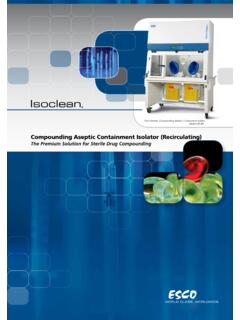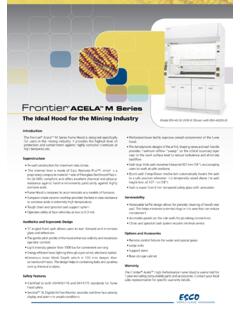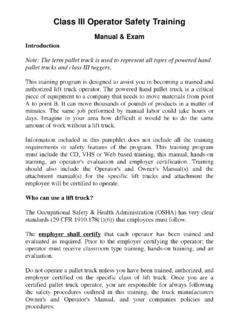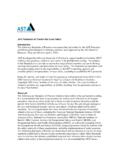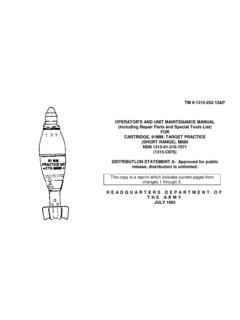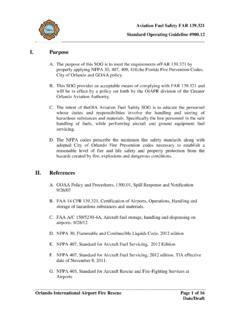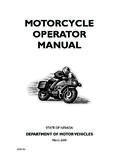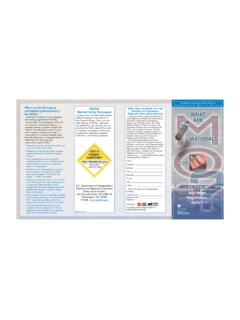Transcription of A Guide to Biosafety & Biological Safety Cabinets
1 A Guide to Biosafety & Biological Safety CabinetsForewordThis booklet was developed as a Guide to Biological Safety Cabinets and provides basic knowledge of Biosafety and Biological Safety Cabinets . The information presented is unbiased and generic in nature compiled with help from experienced microbiologists, engineers and Safety enclosure BIohazards and Biosafety LeveLsThe word biohazard is a contraction of the words Biological and hazard, and defined as: an infectious agent, or part thereof, presenting a real or potential risk to the well-being of man, animals and / or plants, directly through infection or indirectly through disruption of the environment. Biosafety Levels 1 through 4 were established by the Centers for Disease Control (CDC) and the National Institutes of Health (NIH) and are combinations of laboratory practices and techniques, Safety equipment and facilities.
2 All of these levels are appropriate for the biohazard posed by the agents used and for the laboratory Level 1 Practices, Safety equipment and facilities appropriate for work with defined and characterized strains of viable micro organisms not known to cause disease in healthy adult humans. The laboratory is not necessarily separated from the general traffic patterns in the building. Work is generally conducted on open bench tops using standard microbiological practices. Special containment equipment or facility design is neither required nor generally used. Laboratory personnel have specific training in the procedures conducted in the laboratory and are supervised by a scientist with general training in microbiology or a related science.
3 A Biological Safety cabinet is generally not required for work involving these Level 2 Practices, Safety equipment and facilities appropriate for work done with a broad spectrum of indigenous moderate-risk agents present in the community and associated with human disease in varying severity. It differs from Biosafety level 1 in that:a) laboratory personnel have specific training in handling pathogenic agents and are directed by competent scientists; b) access to the laboratory is limited when work is being conducted; c) extreme precautions are taken with contaminated sharp items; and d) certain procedures in which infectious aerosols or splashes may be created are conducted in Biological Safety Cabinets or other physical containment equipment.
4 A class I or class II Biological Safety cabinet is highly recommended for work involving these Guide to Biosafety & Biological Safety Cabinets Biohazards and Biosafety LevelsBiosafety Level 3 Practices, Safety equipment and facilities appropriate for work done with indigenous or exotic agents with a potential for respiratory transmission which may cause serious and potentially lethal infection. More emphasis is placed on primary and secondary barriers to protect personnel in the contagious area, the community, and the environment from exposure to potentially infectious aerosols. A class I or class II Biological Safety cabinet is required for work involving these Level 4 Practices, Safety equipment and facilities appropriate for work done with dangerous and exotic agents which pose a high risk of life threatening disease.
5 May be transmitted via the aerosol route, and for which there is no available vaccine or therapy. Members of the laboratory staff have specific and thorough training in handling extremely hazardous infectious agents and they understand the primary and secondary containment functions of the standard and special practices, the containment equipment, and the laboratory design characteristics. They are supervised by competent scientists who are trained and experienced in working with these agents. Access to the laboratory is strictly controlled by the laboratory director. The facility is either in a separate building or in a controlled area within a building, which is completely isolated from all other areas of the building. A specific facility operations manual is prepared or adopted.
6 A class III Biological Safety cabinet is required for work involving these : Biosafety in Microbiology and Biomedical Laboratories, Department of Health and Human Services, HHS publication (CDC) 99-8395, 4th Edition. April 1999. p LevelInfectious agentsexamplesPractices and techniquessafety equipment(Primary Barriers)Facilities (secondary Barriers)1 Not known to consistently cause disease in healthy adultsBacillus subtilis, Naegleria gruberi, Infectious canine, hepatitis virus, MicrobiologicalpracticesNone RequiredOpen benchtop sink with human disease. Primary hazards are percutaneous injury, ingestion, mucous membrane exposureMeasles virus, salmonellae,Toxoplasma spp,Hepatitis B 1 plus: Limited access Biohazard warning signs Sharps precautions Biosafety manual defining any needed waste decon- tamination or medical sur veillance policies Respiratory protection as requiredPrimary barriers: class I or II BSCs or other physical containment devices used for all manipulations of agents that causesplashes or aerosols of infectious protective equipment: lab coats,gloves, face protection as neededLevel 1 plus: Autoclave available3 Indigenous or exotic agents with potential for aerosol transmis-sion, disease may have serious or lethal consequencesM.
7 Tuberculosis, St. louis encepha-litis virus, Coxiella Burnetii, Bacillus anthracis (production level)Level 2 plus: Controlled access Decontamination of waste Decontamination of lab clothing Baseline serum samples of lab personnelPrimary barriers: class I or II BSCs or other physical containment devices used for all open manipulations of protective equipment: lab clothing, gloves, respiratory protection as neededLevel 2 plus: Physical separation from access corridors Self-closing, double door access Exhaust air not recirculated Negative airflow into laboratory4 Dangerous / exotic agents that pose a high risk of life threat-ening disease. Aerosol-transmitted lab infections or related agents with uknown risk of transmissionEbola zaire, Sin Nombre Virus, Rift Valley FeverLevel 3 plus: Clothing change before entry into lab Shower on exit All material decontaminated on exit from labPrimary barriers:All procedures conducted in class III or I or II BSCs in combination with full-body, air-supplied, positive-pressure personnel suitLevel 3 plus: Separate building or isolated zone Dedicated supply/exhaust vacuum, and decontamination systems Additional requirements as outlined in Biosafety in Microbiological and Biomedical LaboratoriesSource.
8 Biosafety in Microbiology and Biomedical Laboratories, Department of Health and Human Services, HHS publication (CDC) 99-8395. 4th Edition. April 1999. p 1. Summary of Biosafety Levels and Infections Agents4A Guide to Biosafety & Biological Safety Cabinets Biohazards and Biosafety LevelsII. Biological Safety caBInetsThe terms Biological Safety cabinet and Biosafety cabinet have been widely used to describe a variety of containment devices equipped with HEPA filter(s), designed to provide personnel or both personnel and product protection from biohazardous materials. The terms should only be applied to those devices that meet the requirements of class I, II, or III specifications, based on their construction, airflow velocities and patterns, and their exhaust International Standards for Biological Safety Cabinets : American Standard NSF 49 European Standard EN 12469 Australian Standard AS 2252 Japanese Standard JIS K 3800 Table 2.
9 Biological Safety Cabinet ClassesSource: Laboratory Biosafety Manual. Second Edition (revised). Interim guidelines. World Health Organization. p32.* Pressure differential between chamber and (m/s)recycle air (%)exhaust air (%)control Plenumsurrounded byexhaust AirInside room / Hard duct1, 2 & 3II Type A1 AirInside room / Thimble duct1, 2 & 3II Type A2 PlenumInside room / Thimble duct1, 2 & 3II Type B1 Plenum Hard duct only1, 2 & 3II Type B2 EN:NA0100 Negative PlenumHard duct only1, 2 & 3 IIIC losed: * > WC0100 Negative PlenumInside room / Hard duct1, 2, 3 & 45class I Biological Safety Cabinets The class I cabinet has the most basic and rudimentary design of all Biological Safety cabinetry available today. A stream of inward air moving into the cabinet contains aerosols generated during microbiological manipulations.
10 It then passes through a filtration system that traps all airborne particles and contaminants. Finally, clean, decontaminated air is exhausted from the cabinet. The filtration system usually consists of a pre-filter and a HEPA (High Efficiency Particulate Air) the class I cabinet protects the operator and the environment from exposure to biohazards, it does not prevent samples being handled in the cabinet from coming into contact with airborne contaminants that may be present in room air. Naturally, there is a possibility of cross-contamination that may affect experimental consistency. Consequently the scope and application of class I Cabinets is limited and it is largely considered obsolete. All class I Biological Safety Cabinets are suitable for work with microbiological agents assigned to Biosafety levels 1, 2 and II Biological Safety Cabinets Like class I Safety Cabinets , class II Cabinets have a stream of inward air moving into the cabinet.



